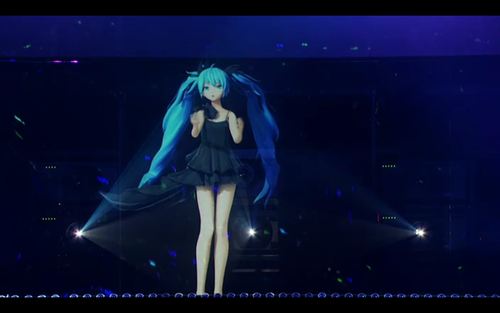|
The first time I saw Hatsune Miku in concert, I started scribbling notes. “It’s Rei Toei!!” was the first thing I wrote. That was the 2011 Live in Sapporo show, simulcast to movie theaters in nine U.S. cities. Last weekend, celebrating the Japanese digital idol’s sixth birthday (well, her sixth 16th birthday…), Miku’s Magical Mirai concert was broadcast on delay to just two cities here (LA and NYC) — but the show was a remarkable improvement and a blockbuster performance all around. I couldn’t help but scribble more notes, including this possibly more telling one as Miku appeared with a guitar: “Transformation to Madonna complete.” What a difference two years makes in the tech. While the 2011 show actualized Miku with two projectors, Saturday’s show featured five of them. The image of Miku seemed of significantly better resolution, too, without necessarily being any more photo-realistic. The sharp visuals enhanced the fashion design above all — and there were a lot of costume changes. Miku opened the show with “Sweet Devil” (HachioujiP), in a spiffy black outfit with pink-trim and visible garters. She wore numerous costumes, including her requisite school uniform and her Magical Mirai ensemble. (Her “01” tattoo — a model number, not a binary allusion — seemed crisper than ever.) Most costume changes were made in the blink of an eye, sometimes in a swirl of special-effect fairy dust or, in one case, a “Star Trek”-like transporter beam.
Same for the appearance and disappearance of occasional microphone stands. This is still one of my favorite aspects of Miku’s visual communication — there is no voice requiring amplification from the stage (her synthesized vocals are pre-programmed and fed direct to the speaker mix), but she still appears with microphones most of the time. It’s usually a subtle headset, but she pulls out the actual mike when she requires the foregrounding of its emotional cues. A microphone is something to hang on, to grasp passionately, a visible channel through which to emote — and it remained a very effective prop during performances such as “Cat Food” (Doriko) and “Tell Your World” (KZ[Livetune]). The wider projection field allowed for more romping (though the hologram simulations still tend to dissipate during fast motion) and more people on stage. Other Vocaloids joined the show, on their own and in duet or trio with Miku, including Megurine Luka and Meiko (designers are still struggling to master the movement of hair but, especially with these two, they clearly have been spending time perfecting the particular bounce of breasts), as well as Kaito and the (!) break-dancing Len Kagamine. The show was a full two hours — including a surprisingly long wait for the encore (is Miku developing a celebrity ego?) — and featured 24 songs (setlist). Both the Los Angeles and New York shows were sold out, so maybe there’s an audience for digital vocal agents in the West, after all. I attended the LA show with an excited and diverse audience (and with only two serious cosplay attendees, though they both enhanced the feeling of being in Japan by also wearing surgical masks as they waited in line outside), all waving their glow sticks as if ringing hand bells. Kudos to my intrigued but bewildered companion, Jamie; I owe you a tasty beverage in a cafe featuring some nice soft, acoustic music. (Some rehearsal video is here.) (Photo from here)
0 Comments
Leave a Reply. |
this blahg
I'm THOMAS CONNER, Ph.D. in Communication & STS, and a longtime culture journalist. Categories
All
Archives
June 2024
|


 RSS Feed
RSS Feed